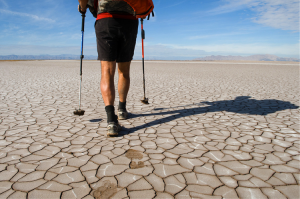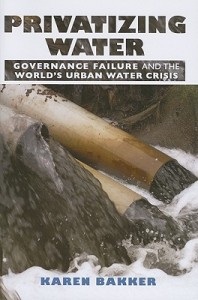Every year, more people die from water-related illness than all forms of violence combined. Polluted water is deadly, and it is the poor in developing countries, and children in particular, that suffer most from unclean water and inadequate sanitation.
In Ethiopia, more than 60 percent of the population lacks access to clean drinking water. Most Ethiopians must therefore buy expensive water from private vendors, or collect water from untreated sources, putting them at risk of contracting life-threatening diseases like cholera and typhoid.
We have the know-how to solve these water challenges and save millions of lives. What’s needed is global political will and public pressure for clean water infrastructure. Fortunately, world leaders have a vital opportunity to transform the global water policy agenda with the expiration of the Millennium Development Goals (MDGs) next year.
In 2000, world leaders committed to halving the number of people without access to safe drinking water and basic sanitation through the MDGs. Although this target has been achieved — more than 2 billion people have gained access to improved drinking water since 1990 — 1.1 billion people still live without clean drinking water and 2.5 billion people lack basic sanitation. Furthermore, the MDGs have failed to bring clean water to the poorest countries. While millions in Latin America, Asia, and the Pacific have gained access to clean water in recent years, Sub-Saharan Africa has been left behind. Today, over 40 percent of all people that lack access to clean drinking water live in Sub-Saharan Africa.
The privatization of water supplies is partially responsible for Sub-Saharan Africa’s lack of progress on the MDG for water and sanitation. Although the UN Task Force on the MDGs has avoided taking a firm position on privatization, the UN has given the World Bank and other major donors the authority to finance water projects in developing nations. The World Bank avidly promotes water privatization in Sub-Saharan Africa as a means of meeting water-related MDGs. The World Bank invests directly in corporate water giants like Biwater and Suez, which have been behind failed privatizations in Tanzania, South Africa, and other countries. These companies use the rhetoric of the MDGs to justify private sector involvement in water services, even while they prioritize profit and shareholder interests over affordable water access.
Private sector involvement in the supply of water in Sub-Saharan Africa is problematic because it has failed to extend clean, affordable water infrastructure to the poor. For instance, when the city government of Dar es Salaam, Tanzania handed its water system over to Biwater, many Tanzanians experienced soaring water bills and mass disconnections from the network. Rather than paying high prices for water that had previously been provided for free, many low-income families instead decided to consume contaminated well water. Thus, water privatization can be financially crippling and life-threatening for the urban poor of Sub-Saharan Africa. While there is a role for international financial institutions and the private sector in the fight for clean water, there is no justification for international agencies and corporations to continue promoting water privatization.
With the expiration of the MDGs in 2015, world leaders have the power to create a new set of water policies that prioritizes extending clean, affordable water to the poor. In place of the current MDGs, new action-oriented Sustainable Development Goals (SDGs) are being drafted as part of the UN’s Post-2015 Development Agenda. The SDGs have the potential to address many of the shortcomings of the MDGs, such as their neglect of the poorest countries and most excluded people, especially in Sub-Saharan Africa.
The dire need for better access to clean water and sanitation is an important part of the SDGs discussion. The SDGs Open Working Group has identified water and sanitation as potential focus areas for the SDGs, and has outlined actions such as expanding wastewater treatment infrastructure, and ensuring safe access to safe and affordable drinking water for all. However, in its most recent proposal for the SDGs, the Open Working Group included a provision for greater involvement of the private sector in the implementation of the SDGs. This agenda is shared by the World Bank, which, as the largest external source of financing for water projects around the world, will have a big say in the creation of a new SDG for water. But it’s critical that the world’s poor have an even bigger say in the water policies that will affect their livelihoods and their health.
Under the current MDGs, corporate-driven, World Bank-backed water projects are allowed to prioritize profit over people’s needs for access. But water management must be returned to public hands, democratically accountable to the people whose interests are at stake. Around the world, public investment and management has been proven to be a more successful model for developing water delivery systems than privatization. And although financial institutions like the World Bank are big and powerful, it’s possible to change their agendas. One organization, Corporate Accountability International, is already at the front lines, challenging corporate abuse of water, forging alliances with grassroots water organizations abroad, and working with legislators to challenge the World Bank’s water policy.
The post-2015 SDGs are a major chance for world leaders, the UN, and the World Bank to join this fight for the human right to water and advocate for democratically controlled public water systems in developing nations. By enshrining support for human rights and publicly controlled water systems in the new SDGs, we can ensure that the needs of the poor are prioritized over corporate interests and the agendas of financial institutions like the World Bank.
The UN General Assembly will meet to discuss the first draft of the Open Working Group’s SDGs in September, so there’s still plenty of time for you to voice your support for public water policy in the nations that need it most.
What you can do:
1. Ensure that increasing access to clean water and sanitation is made a top priority in the SDGs.
Take the MY World survey and vote for clean water and sanitation to become a priority for the SDGs.
2. Tell your elected officials to pressure the World Bank to stop directly funding water corporations and instead implement SDGs that support publicly controlled water systems.
3. Join the global conversation on Twitter and Facebook.





